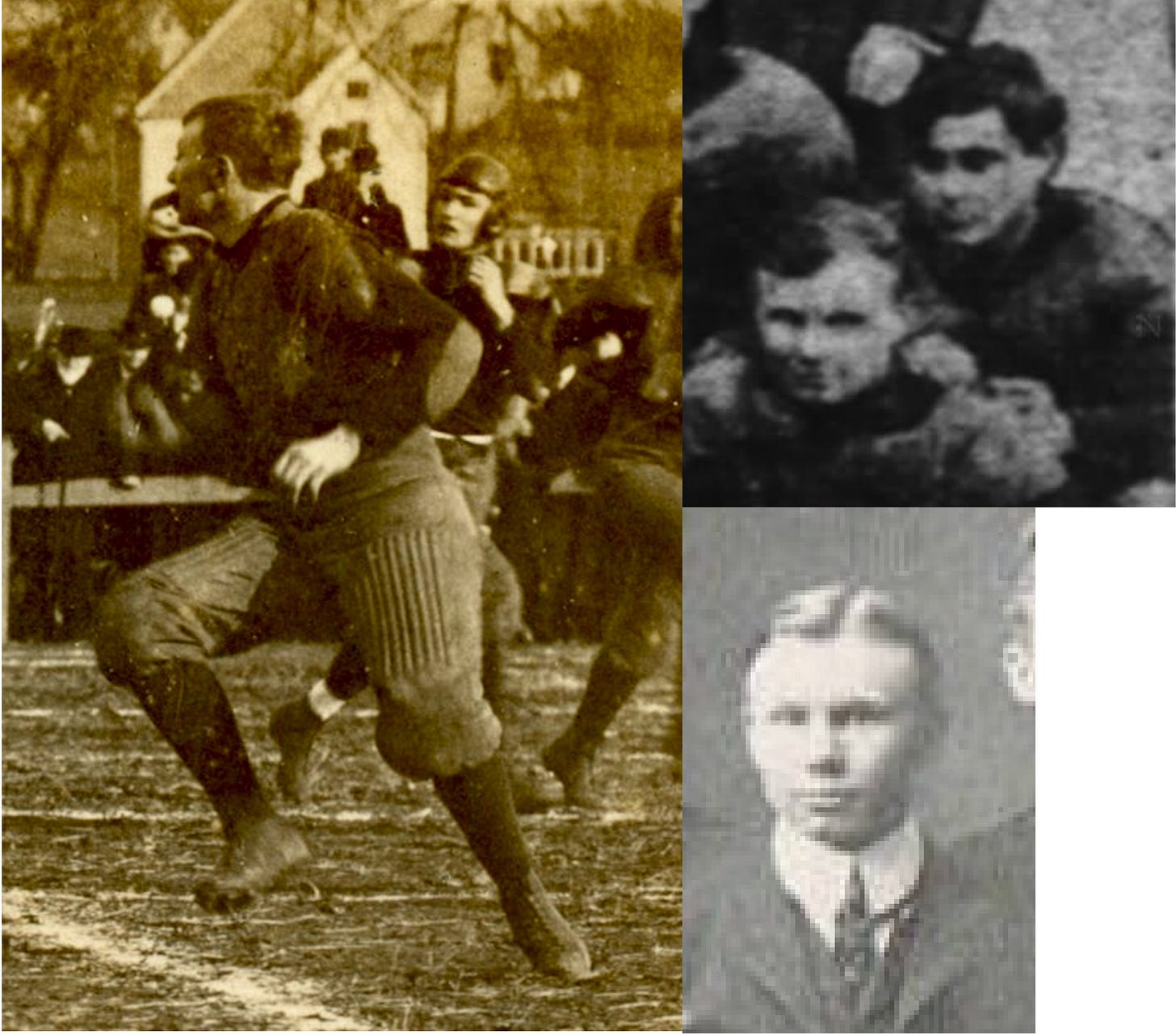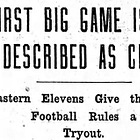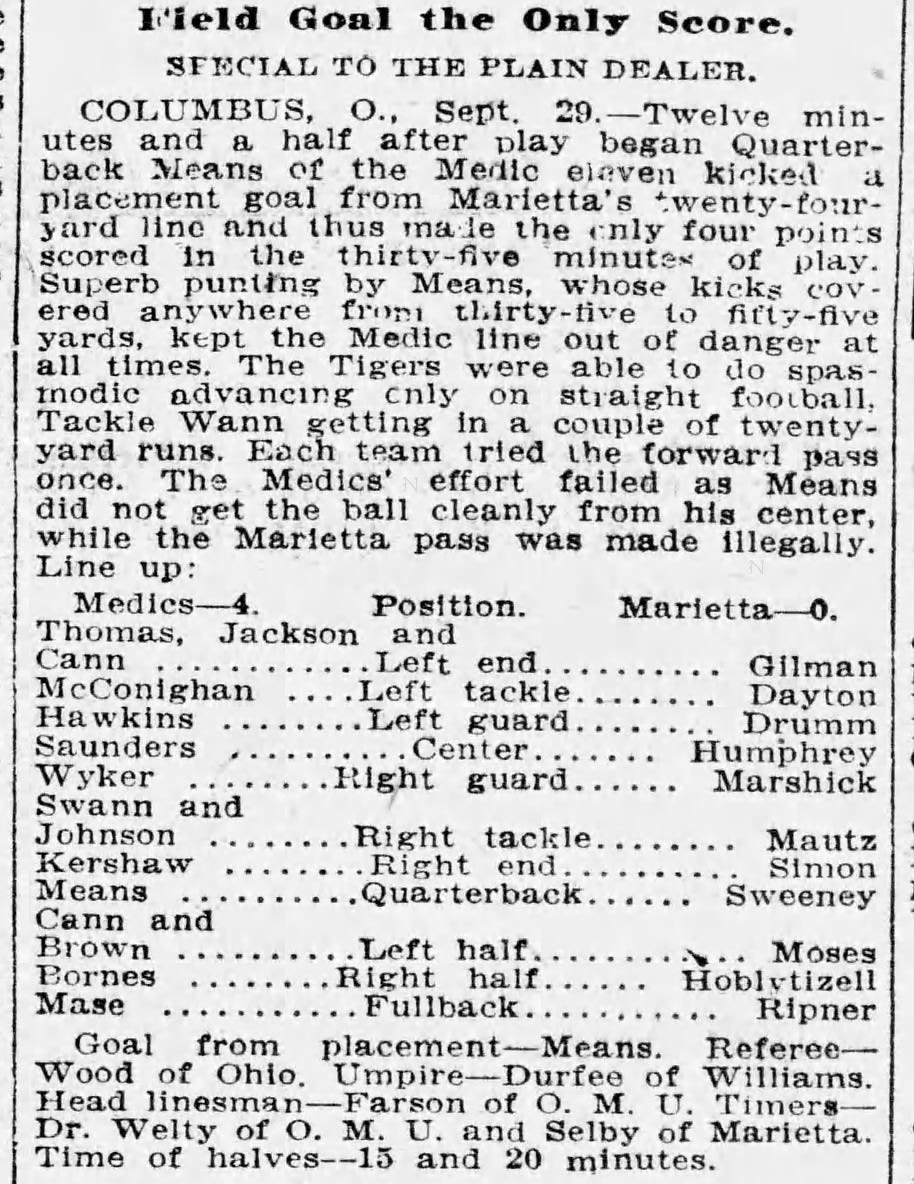Marietta College's Claim to the First Forward Pass
A handful of schools claim or once claimed to have thrown the first legal forward pass in a regular season game. One of those is Marietta College in Ohio. At various times, a pass thrown by Petey Gilman to Verne Moses on Thanksgiving Day 1906 was called the first forward pass, but it never was. In fact, it is unlikely to have been among the first 1,000 forward passes since it came at the end of the 1906 season, and any number of schools attempted forward passes during the season.
Most football historians attribute the first forward pass to St. Louis U, which threw the ball forward several times in their September 25, 1906, game with Carroll College. However, I've shown that New Hampshire threw a forward pass several days before SLU, on September 22, 1906, so even SLU was not the first.
Not only was Marietta's Gilman to Moses connection not the first forward pass in college football, it wasn't even Marietta's first forward pass of the season. A news report regarding their season opener against Ohio Medical University indicates that both teams threw forward passes that day.
So, while it is clear that Marietta did not throw the first forward pass, the Gilman to Moses toss is worth examining due to the existence of a game-action image of the throw, making it one of the earliest known images of a forward pass. Some also claimed the pass held the record for the longest forward pass in football for fourteen years, though I have not found a source to support the claim.
Marietta's coach in 1906 was College Football Hall of Famer Henderson Van Surdam, who played at Wesleyan under H. R. Reiter, one of the early proponents of the overhand spiral. Although Van Surdam's final season at Wesleyan came in 1905, he likely learned the overhand spiral from Reiter, who toyed with it before the forward pass became legal and then used it during the 1906 season.

Passes in 1906 had to be thrown from at least five yards to the right or left of the center. Some teams had the quarterback take the snap and pitch the ball to a running back who rolled out to meet the five yards from the center requirement.
The Marietta mythology indicates that Van Surdam kept the forward pass under wraps as they tore through the 1906 schedule, outscoring their opponents 286-13. One field goal, one touchdown, and two safeties were all that opponents mustered against Marietta, but they chose to pull it out against Ohio, who they figured to be a tough opponent, though Marietta won 12-2. The claim that Marietta threw the first forward pass likely results from Van Surdam, who became a prominent Eastern game official, still making his claim as late as 1970:
The passer had to stand back five yards and you could only throw flat passes. Throwing down the middle was still illegal. We had a tailback standing 12 yards back with two blockers in front of him.
The quarterback took the direct snap from center - paused briefly- and then passed back to the tailback. Meanwhile the left end was streaking down the field. The ball was pumpkin-shaped and you had to sling it side arm, but you could get the job done.
Twombly, Well, 'A Little Old Man,' San Francisco Examiner, June 17, 1970.
The pass is variously described as being 49, 52, or 56 yards, while a newspaper report from the day after the game credited Gilman with a 47-yard pass. The difference may be due to whether one described the distance the ball traveled in the air, the length in the air plus YAC, or the total yards gained. (College football did not have consistent statistics until the late 1930s.)
The yardage differences may also result from a common memory issue in which we apply today's logic to historical events. For example, in 1956, Gilman recalled the ball being on Marietta's 43-yard line when the quarterback called for the pass.
I was in the prescribed position with two backs in front of me. The quarterback (Sweeney) took the ball from the center and pitched it underhand out to me. I was on our 38-yard line.
The way we practiced it, I had the option of passing the ball or carrying it behind the two backs in front of me. I decided to throw it.
…Moses got down to the Ohio 10 and turned around. He was all alone, except for the few spectators who ringed the field. All he had to do was make the catch and run across the goal line.
Smith, Chester, The Village Smithy, Pittsburgh Press, December 21, 1956.
As Moses caught it downfield and scored, the referee, who carried a cane or stick to mark the spot of the play, came over and poked the stick in the spot where Gilman threw the ball. The ref was Branch Rickey, then an Ohio Northern coach and later a top major league baseball executive. Upon seeing the long downfield pass, Rickey exclaimed, "Judas Priest. Did you ever see anything like that?"
If we believe Gilman's retelling that the play originated on Marietta's 43-yard line, it would have been a 67-yard touchdown pass due to American football fields having a 55-yard line in 1906. Alternatively, the ball may have been on Marietta's 53-yard line, leading to a 57-yard pass (assuming Gilman fit the yard line to the football field design at the time he told the story).
Not only is there confusion about the distance Marietta's pass traveled, but the photo of the play is confusing since it is initially unclear whether they threw the ball right to left or left to right. Is the player on the right side lifting his right leg the passer or the receiver?
Through most of the season and for the Ohio game, Gilman started at an end position and Moses at halfback, but they switched spots for the forward passing play since all descriptions tell us Gilman threw the ball to Moses.
Comparing yearbook images of Gilman and Moses shows Gilman is the player on the right, so the image shows him after throwing the ball right to left.

Whatever the length and order of the pass, the image is one of the earliest game-action images of a forward pass.
Unfortunately, I could not find information about Verne Moses' background or what became of him after Marietta. Gilman, on the other hand, grew up in Marietta and attended Marietta Academy before Marietta College. A teammate on the 1902 Academy team was Alf Landon, who moved to Kansas during high school and later became Kansas' governor and the Republican nominee for president in 1936.
Pete Gilman went on to a successful business career with Airolite and was a long-time member of Marietta's Board of Trustees. Marietta's Gilman Student Center, which opened in 1958, is named in his honor.
So, while Marietta cannot rightfully claim to have been the first thrower of a forward pass, they are among the few whose forward flings were caught on the field and film, so they can claim that distinction if they want.
Notice: FootballArchaeology is not subject to Trump’s idiotic tariffs, so the $50 annual subscription is still just $50.
Click Support Football Archaeology for options to support this site beyond a free subscription.








Just to be clear - it is Saint Louis University not St. Louis University.
I will have to go back and read your research regarding the first forward pass.